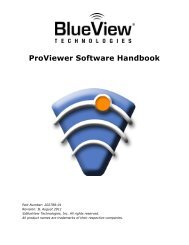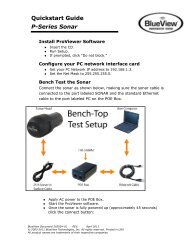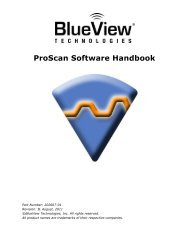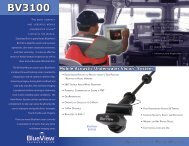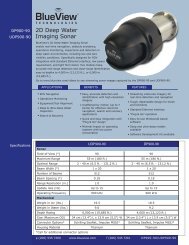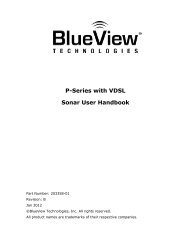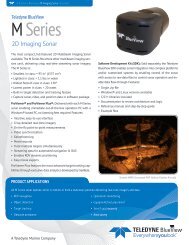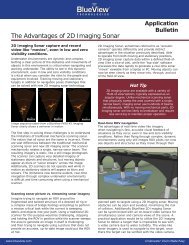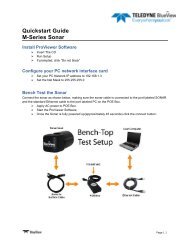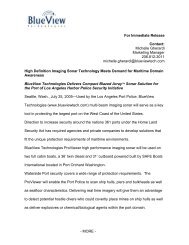Jane's Navy International Features BlueView
Jane's Navy International Features BlueView
Jane's Navy International Features BlueView
You also want an ePaper? Increase the reach of your titles
YUMPU automatically turns print PDFs into web optimized ePapers that Google loves.
Mine warfare sonarNURC: 1193205Large-scale anddetailed imagery fromthe Thales syntheticaperture sonar fittedto the NATO UnderseaResearch Centre’sBluefin-21 MUSCLEvehicle. Visible is aslightly buried dummytarget, shaped like atruncated cone, of1 m diameter and45 cm height. Resolutionis 1.6 m x 5 cm;water depth is 20 m;and sonar altitudeis 10 m.DIDSON data collectedby Bluefin Roboticsand processed byAcoustic View showsthe hull of a ship.Sound Metrics: 1345266operation from Hunt-class MCMVs will beconfigured with an EdgeTech 2200-S 850 kHzside-scan sonar, an Imagenex Delta-T 1.7 MHzimaging sonar and an Edgetech 2200-S4-24 kHz sub-bottom profiler. The REMUS600 has also been fitted with SAS systems providedby Pennsylvania State University/AppliedResearch Laboratory (PSU/ARL) and AppliedSignal Technology, as well as with the KongsbergEM3000 multibeam sonar.HUGIN for NorwayKongsberg’s HUGIN mine reconnaissance system(MRS), based on the HUGIN 1000 AUV,has been evaluated with a number of minehuntingsonars; these include the EdgeTech MP-Xside-scan sonar and EdgeTech 4400, SEN-SOTEK and HISAS 1030 SAS systems. Thecurrent generation of the HUGIN 1000 multirolevehicle includes Kongsberg’s HISAS 1030interferometric SAS, the EM3002 multibeamecho-sounder, the Imagenex forward-lookingsonar and (optionally) a camera and a subbottomprofiler. The evaluation has been donein close co-operation with the Royal Norwegian<strong>Navy</strong> (RNoN), which has had an operableAUV MCM capability for more than five years.The Bluefin-21-based Battlespace PreparationAutonomous Underwater Vehicle(BPAUV), which will feature as part of themine-warfare mission package equipping theUSN’s Littoral Combat Ship (LCS), is designedto travel on a pre-set mission plan, followingwaypoints, while recording bottommaps and other oceanographic data. After thevehicle is recovered, its data will be transferredvia the LCS command-and-control system tothe PMA software.Contact information and environmentaldata will then be uploaded to the Mine Warfareand Environmental Decision Aids Library.The BPAUV is able to map 150 mswaths at depths down to 200 m, with its Klein5500 455 kHz side-scan sonar providing 7.5-10 cm resolution imagery. Eleven BPAUVsQinetiQ: 1039918have been built and delivered to date. TheBluefin-21 has also been fitted with a numberof SAS systems developed by QinetiQ andThales Underwater Systems.The Bluefin-12 vehicle that forms part of theUSN’s Surface MCM Unmanned UnderwaterVehicle Program: Increment 2 (SMCM/UUV-2) is fitted with a QinetiQ SAS, while an ONRownedvehicle is fitted with a PSU/ARL SASdesignated SAS-12, which it demonstrated lastMay at AUV Fest 2008 at the Naval UnderseaWarfare Center in Newport, Rhode Island.Vehicles that are required to identify minesand/or assist in their detonation are likely tocarry forward-looking high-resolution imagingsonars. They can also be employed for the gapfillingrole when using sideways-looking sidescansonars or SAS systems. Other applicationsinclude close-in inspection of ships’ hulls andstructures within ports and harbours for improvisedexplosive devices, as well as obstacleavoidance, target-homing and navigation.One of the smaller manufacturers is Blue-View Technologies, which produces bothhigh-resolution two-dimensional (2-D) imagingand three-dimensional (3-D) microOperations with the Bluefin-21 Gambit UUV forthe UK RN have helped shape the developmentof the QinetiQ SAS payload.bathymetry sonars. Commercial off-the-shelf(COTS) types are the <strong>BlueView</strong> 2-D 450 kHzand 900 kHz imaging sonars (P450E-15,P900E-20 and DF900-2250) and the MB1350and MB2250 microbathymetry systems, operatingat 1,350 kHz (~1-inch [2.5 mm] rangeresolution) and 2,250 kHz (~0.6-inch range resolution)respectively. <strong>BlueView</strong> has a matureSoftware Development Kit that is a library of C/C++ routines that enable low-level access to thesonar control routines and data output, allowingAUV control programmes to also control thesonar, read data and interpret it, and cause thevehicle to respond to the sensed imagery.For tighter integration with specific UUVplatforms, <strong>BlueView</strong> has been building customengineered-to-order versions of its sonar systems,including those providing multiple forward-lookingfields of view (both horizontaland vertical, or multiple frequency), widerfields of view (90 degrees rather than theconventional 45 degrees) and combinationforward-looking and microbathymetry functionalityin the same sonar attachment.At AUV Fest 2008, two Nekton Researchman-portable Ranger UUVs, each fitted witha <strong>BlueView</strong> N900X sonar, demonstrated automatedhoming on simulated mine targets. Atthe same demonstration two Ranger UUVsequipped with an N900X used algorithmsdeveloped by the Massachusetts Institute ofTechnology (MIT) to automatically detect andtrack sonar image features in 46 successfuldata-collection missions. Other UUVs thathave incorporated <strong>BlueView</strong> sonars are theBluefin Hovering AUV, REMUS 100 and theUS Naval Postgraduate School’s Aries vehicle.Another high-resolution imaging sonar isthe DIDSON (Dual-frequency IDentificationSONar), an acoustic lens-based sonar systemable to produce high-resolution images for theinspection and identification of underwater objects.The sonar was developed at the AppliedPhysics Laboratory, University of Washington,with funding from the USN’s Space and NavalWarfare Systems Command, and is now manufacturedby Sound Metrics.The standard system operates at two frequencies(1.8 MHz and 1.1 MHz) and uses acousticlenses, which provide sharp images from1 m to more than 30 m in range. The longerrangesystem results in a lower resolution buthas a range up to 90 m. DIDSON has beenevaluated on both the REMUS 100 and theBluefin Hovering AUV developed jointly byBluefin and MIT under ONR and EOD ProgramOffice funding, and part of US Naval SeaSystems Command’s EOD Hull UnmannedVehicle Localization System (HULS) contract.The basic principle of the SAS is to combinesuccessive pings coherently along aknown track in order to form an image withmuch higher resolution than conventional sonars–typically 10 times higher. The azimuthor along-track resolution of a sonar can becomputed as the ratio between the acousticwavelength and the length of the array. A longerarray will increase this ratio but fitting sucha long array is not always possible or practicalon most underwater vehicles. Operation at ahigher frequency will increase the ratio but willat the same time limit the achievable rangedue to higher acoustic attenuation. The SAS28 jni.janes.com n JANE’S NAVY INTERNATIONAL JUNE 2009



